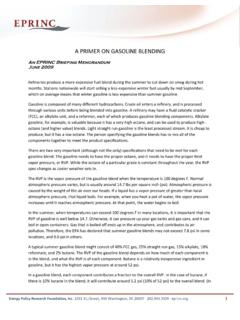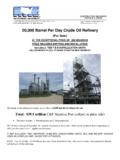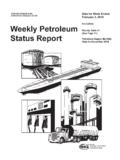Transcription of A Primer on the Canadian Oil Sands - EPRINC
1 A Primer on the Canadian Oil Sands An EPRINC Briefing Memorandum November 2010. Overview Canadian oil Sands have long been recognized as one of the world's largest endowments of oil resources with over 170 billion barrels in place. The resource endowment places Canada second only to Saudi Arabia. Canada's oil Sands are located in Alberta, and unlike conventional crude oil, the oil Sands come in the form of bitumen, a heavy, thick, and viscous substance that requires more intensive extraction techniques than traditional oil production.
2 Oil Sands are produced either from surface mining or in situ processes (see Figure 1). About 80 percent of the recoverable oil Sands reserves can be extracted using in situ methods, which in contrast to surface mining, cause less damage to the local environment. SAGD (Steam Assisted Gravity Drainage) is the most common form of in situ production and is energy intensive because it uses steam generated from natural gas to heat the bitumen so it can flow to the surface (see Figure 2 below). About 20 percent of the oil Sands are recoverable through mining operations where oil Sands are scooped from the surface and moved in trucks.
3 Mining methods scar the landscape and have historically required long time periods to complete reclamation programs, particularly given that tailings ponds can take up to thirty years to fully settle. 1 These two methods of production, mining and in situ, contribute higher volumes of greenhouse gas (GHG). emissions than the production of conventional crude oil because of the relatively high energy use and/or removal of the land surface. 1. Tailings ponds are used in mining operations to let fine particles of residual bitumen, clay, and water settle over time.
4 This generally takes years and has come under considerable controversy for its water usage, sanitation, bird deaths and considerably long land reclamation times. Tailings ponds constitute around 50 square miles of land (NEB 2009 info from Terra Simieritsch converted from km). Recent technology from individual companies operating in the oil Sands will allow tailings extractions to settle in weeks instead of years, increasing land reclamation possibilities. Energy Policy Research Foundation, Inc. 1031 31st Street, NW Washington, DC 20007 1.
5 Figure 1. Understanding Canada's Oil Sands Source: EPRINC diagram, information from Government of Alberta. mbd (million barrels per day). Energy Policy Research Foundation, Inc. 1031 31st Street, NW Washington, DC 20007 2. Figure 2. Types of Production Source: SAGD diagram EPRINC , background photo of SAGD and Mining from Microsoft Oil companies engaged in oil Sands production have been exploring alternative extraction processes to address Canadian regulatory constraints on GHG emissions. In situ production relies heavily upon natural gas to generate steam and as a result its GHG emissions are higher than surface mining.
6 However, production through surface mining causes much more damage to the land and often draws more public concern and criticism than in situ Because of the public concern over surface mining, combined with growing advancement in in situ technology, production from in situ methods is likely to exceed output over surface mining in the future. In situ operations began less than ten years ago, but have reduced their steam usage by 15 percent since that Since bitumen is viscous oil, it must either be upgraded into a synthetic crude oil (SCO) or diluted with condensate (or another natural gas liquid) so it can flow down a pipe and be transported to a refinery.
7 This latter option has the potential to meet the feedstock requirements of complex refineries because diluted bitumen (also called dilbit) from in situ 2. Mining operations cause more damage to the surface than in situ operations, have considerably long reclamation times for tailings ponds, and also use more water than in situ production. For every one barrel of mined bitumen produced, 2 to 4 barrels of fresh water are needed. For every one barrel of in situ bitumen, .5 barrels of fresh water are needed (CAPP 2009).
8 3. IHS CERA. September 2010. Special Report on Canadian Oil Sands , Greenhouse Gases, and US Oil Supply.. Energy Policy Research Foundation, Inc. 1031 31st Street, NW Washington, DC 20007 3. production is similar to conventional heavy crude. 4 Upgraded bitumen yields a synthetic crude oil that is similar to a light conventional crude. Last year all mined bitumen was upgraded into synthetic crude while just a fraction of in situ bitumen was Figures 7 and 8 illustrate the typical outcome of oil Sands bitumen according to its production method.
9 Figure 3. Typical Outcome for In Situ Produced Bitumen Figure 4. Typical Outcome for Mined Bitumen Source: EPRINC and NEB information. 4. Diluted bitumen can usually be refined by complex refineries with little adjustment. See EPRINC 's paper on The Value of Canadian Oil Sands addressing the benefits of heavy oil Sands to complex US refineries at 5. 9 percent of in situ produced bitumen was upgraded. NEB 2009. Energy Policy Research Foundation, Inc. 1031 31st Street, NW Washington, DC 20007 4. Cost of Production Rising oil prices have made the once uneconomic oil Sands production profitable and have allowed for increased investment and significant advances in technology.
10 Estimates vary on the cost of production for a barrel of Canadian oil Sands and this is understandable given the different forms in which a barrel is produced and whether or not the bitumen is upgraded. In 2005 the National Energy Board 6 assessed the supply and operating costs for producing a barrel of Canadian oil Sands . Figure 9 shows the estimated operating and supply costs by extraction method. Costs have been converted from Canadian 2005 dollars to US 2010 dollars. (Note that in 2005, the price for a barrel if oil was in the $40 range.)







